| Photojournal
- 10 June 2006
Homebuilding
|
Saturday, the 10th
of June was a rare day. I got up in the morning with a plan of
heading out to Grant Narrows Park in Pitt Meadows. A little after
9:00 I was out the door and on my way. Birders had recently reported
a male American Redstart from the nature dyke at the park, and
also had found a flycatcher who sang a funny tune. I was eager
to see and hear these birds, the redstart in particular. I'd seen
one before, and he was quite the dashing little guy.
Along the road to the
park, I stopped a few times to investigate birds I noticed. One
of these stops netted me a Brown-headed Cowbird.
|
|
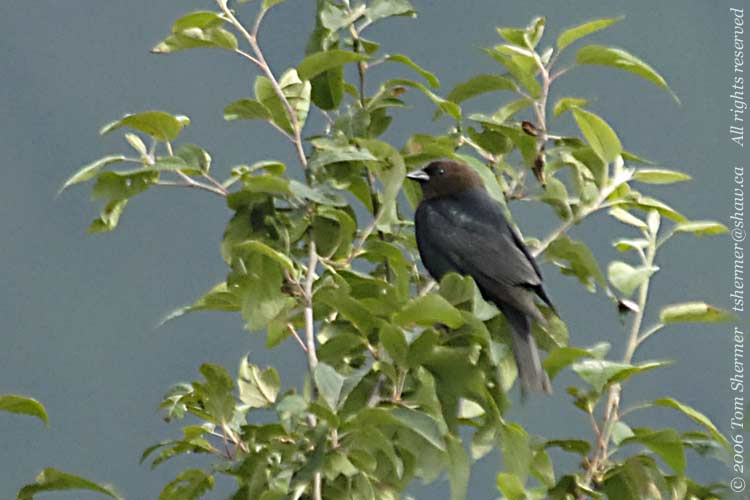 |
| And another
got me some great views of an Osprey perched in the top of a tree
by the river, with a fishy bit of breakfast hanging on the branch
between his feet. |
|
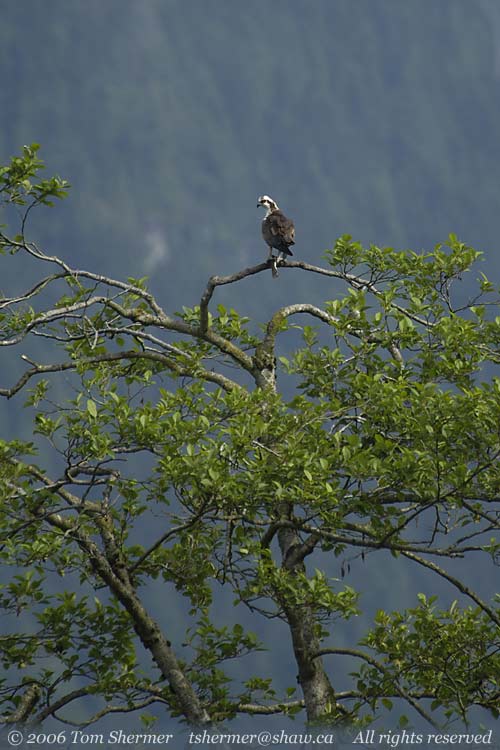 |
|
Luckily I had eaten
a little before going out, so that really didn't make me hungry.
Once I was at the park,
I figured "when in Rome," and parked. (The full quotation
being, "when in Rome, roam" or something like that.)
I got my camera off the seat beside me and my tripod from the
trunk, and headed off down the nature dyke.
After only about a
minute, I found my first neat bird: a Band-tailed Pigeon. He was
the first one I'd seen this year. He was perched on a snag with
a bright overcast sky behind him, which would prevent me from
getting a good portrait shot, so I decided on a shot that placed
him in his context instead.
|
|
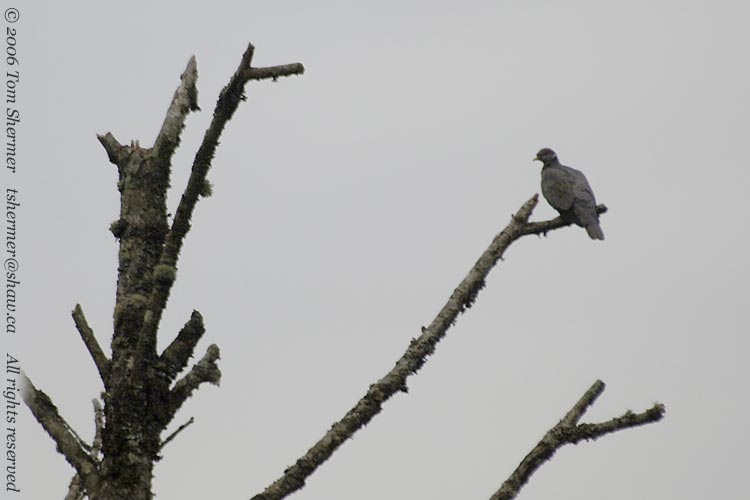 |
| I walked
only a little ways further before noticing a pair of slugs having
a feast on the trail in front of me. It seems that a very tasty
bush or tree limb had fallen. |
|
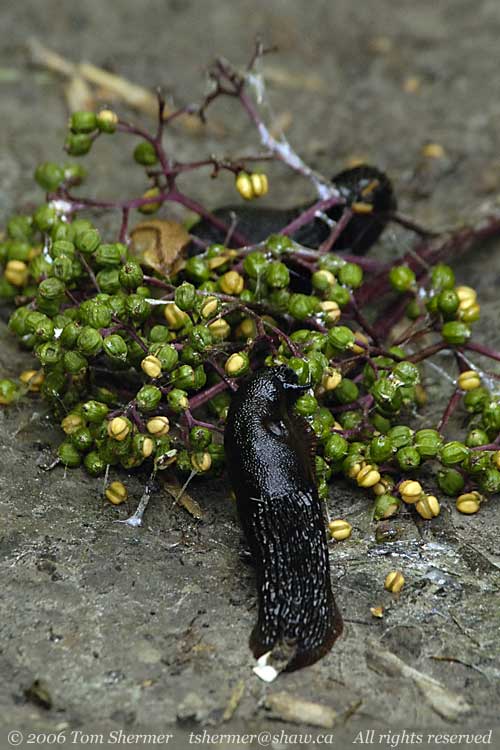 |
|
Speaking of being in
Rome, ancient Romans would've called those slugs Arion rufus,
if they'd read their Linnaeus. Here in B.C. we just call them
Chocolate Arions.
I continued down the
path for a few minutes, noting how nicely maintained it was. I
hadn't been this way in almost a year, and in the meantime they'd
trimmed back the bushes, removed or cut through some fallen trees,
and repaired potholes in the trail. Walking the nature dyke last
year used to involve a little climbing, ducking, pushing through
vegetation, and careful footwork. This year it was a walk in the
park.
I paused in my appreciation
of the trail maintenance when I saw a flash of red up ahead. Zeroing
in on the color, I found a Red-breasted Sapsucker on a small tree
right next to the trail. I only got a few shots off before he
shot off.
|
|
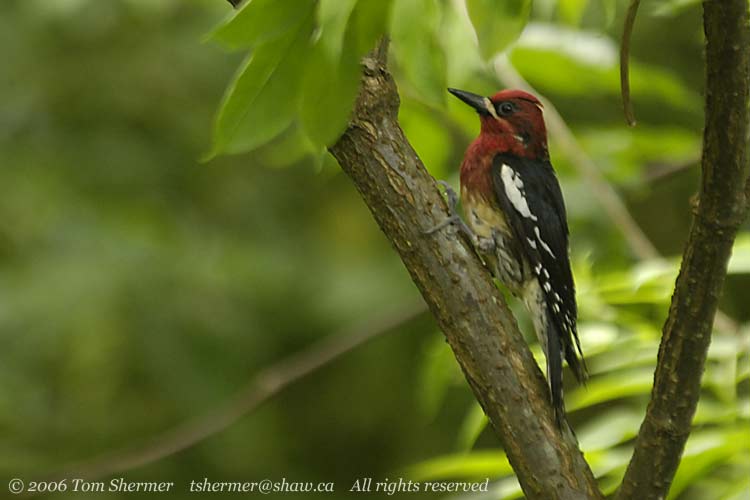 |
|
That was a pretty neat
encounter; these sapsuckers are attractive birds.
Before I had a chance
to even move, I noticed a couple of birds chasing each other in
the trees to my right. I quickly ascertained that they were more
woodpeckers, and when they stopped, I was able to tell that they
were Downy Woodpeckers. We get another woodpecker in these parts,
the Hairy Woodpecker, that looks very much like the Downy, and
it's not always easy to determine which you've got, especially
when the bird in question is flying from place to place.
Anyhow, I did manage
to get some photos of one of the Downies. They're not as showy
as the Sapsucker, but they're still pretty cute little birds.
|
|
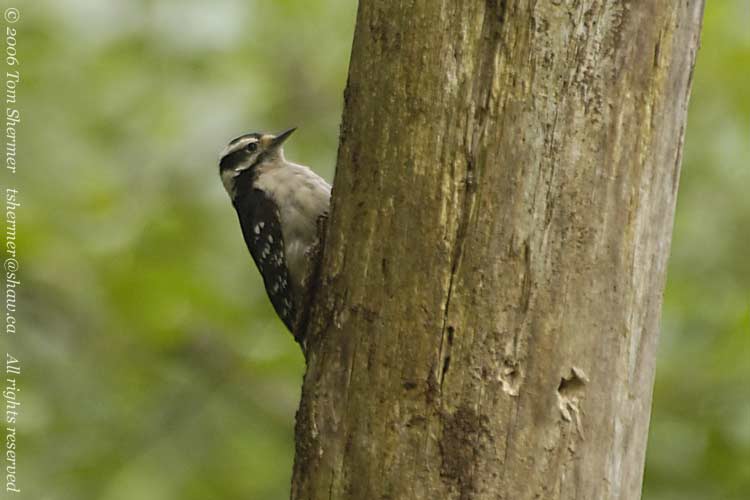 |
| As I had
walked down the trail, I had been hearing Swainson's Thrushes calling
from the trees. Swainson's Thrushes are one of the few birds whose
calls I recognize. Typically I hear them a lot and have a very hard
time finding them, as they like to hang out in deep cover in the
trees. But this time I got lucky and found one perching in the open.
The overcast sky made for another difficult shot, but at least I
got a little something of him. |
|
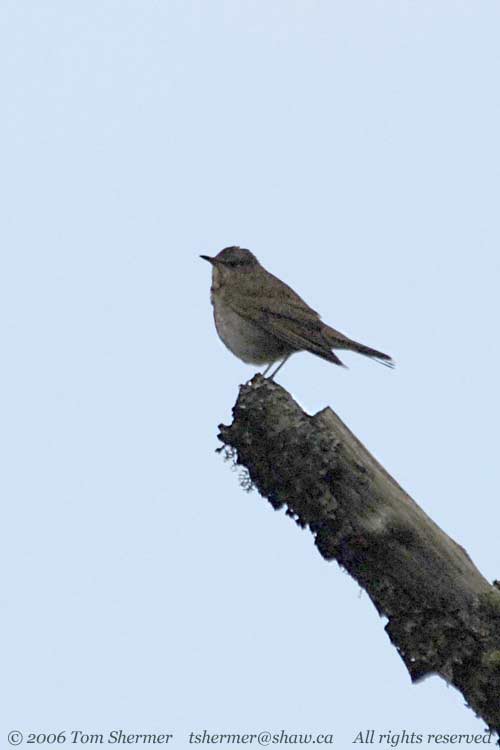 |
| The next
stop I made along the trail was for a very cool insect. It was the
antennae on this fellow that caught my eye. |
|
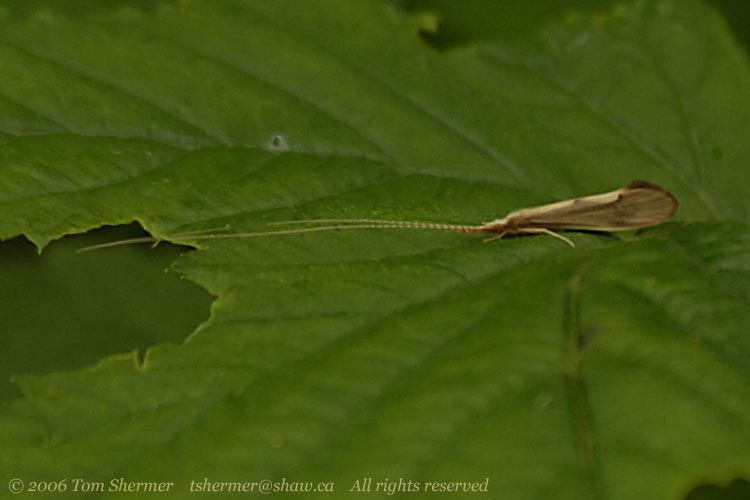 |
|
As I'm sure you all
know, but I didn't at the time, he's a Long-horned Caddisfly of
some sort. That puts him in the family Leptoceridae; he
can further be placed in the genus Trianodes, but if you
want to know the species, you'd have to have the bug in your hand
and be a well-trained entomologist, which I'm not. Not that I
don't want to be, though.
The next fellow I met
wasn't an expert on bugs, either—he mainly eats berries.
He was a Cedar Waxwing, and he and several of his friends had
just arrived in the trees on my right.
|
|
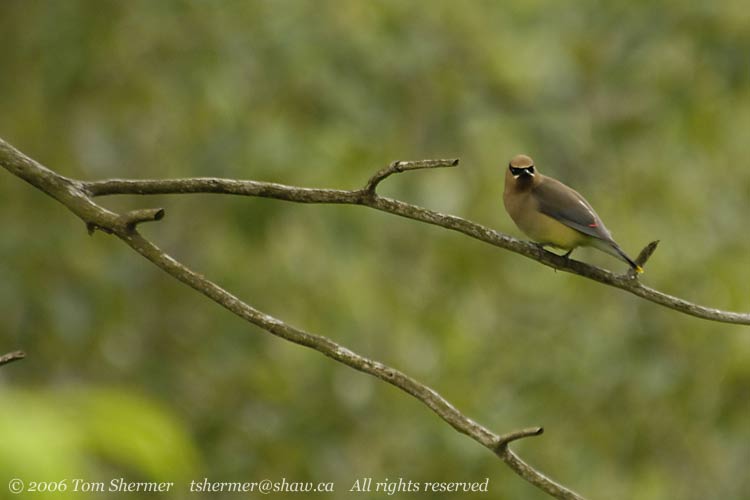 |
| A little
ways further along I found myself in amongst a small flock of Black-capped
Chickadees. I've always got time to stop and watch Chickadees...they're
really friendly and curious little birds. |
|
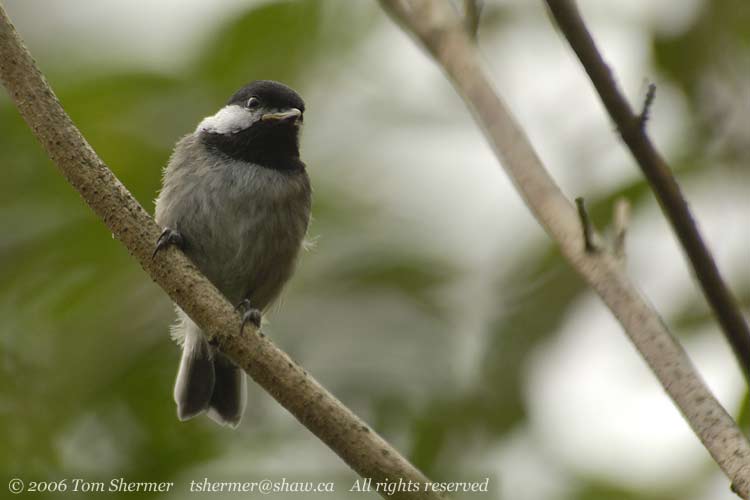 |
| For those
of you not familiar with the dyke, on either side of the trail there
are some bushes and trees, but not too many. After three or four
trees a marsh starts on the north side (the left as you walk out
the dyke) and after one or two there's a slough on the south. My
next sighting, a Bewick's Wren, was on the left about as far away
from the trail as she could be without being in the marsh. I had
to move around a little to find a clean line of sight to her. I
was happy she didn't fly while I was getting set up. |
|
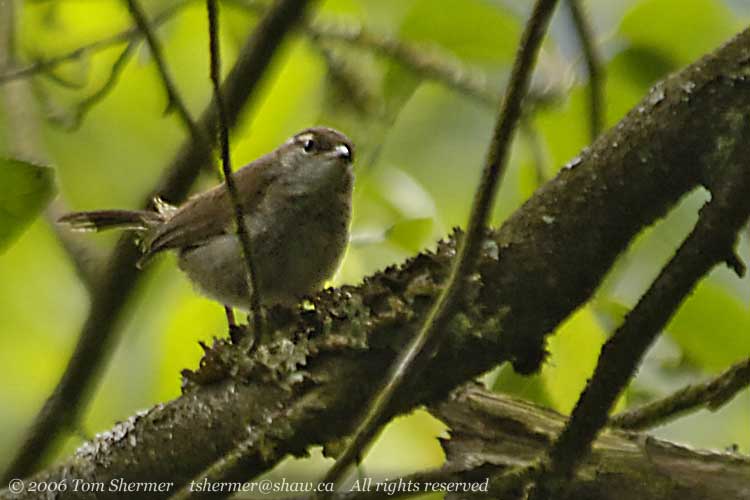 |
|
On the path ahead of
me, there were some Song Sparrows. As I approached, one of them
flew up to a perch on a tree where I could see him. (Often they
scatter into the underbrush on the side of the trail, and I never
find them.) Right after I got the camera set for photos, he launched
off his perch, and I caught a shot of his takeoff.
|
|
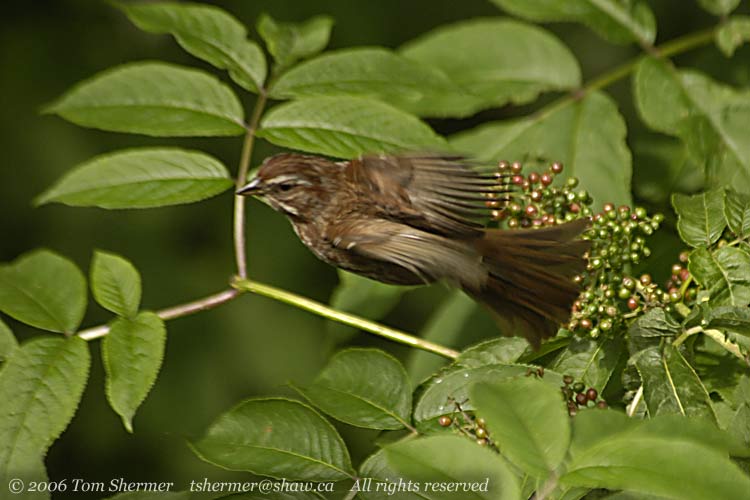 |
|
I reached the end of
the nature dyke without having seen the funny flycatcher or the
redstart, and I vowed to look more carefully on my return.
First, though, I was
going to check out the observation tower and the cottonwoods that
lined the next part of the trail.
When I arrived at the
observation tower, I found a pair of Barn Swallows flying around,
and soon determined that they were building a nest under the stairs.
Here's one of them, carrying nesting materials.
|
|
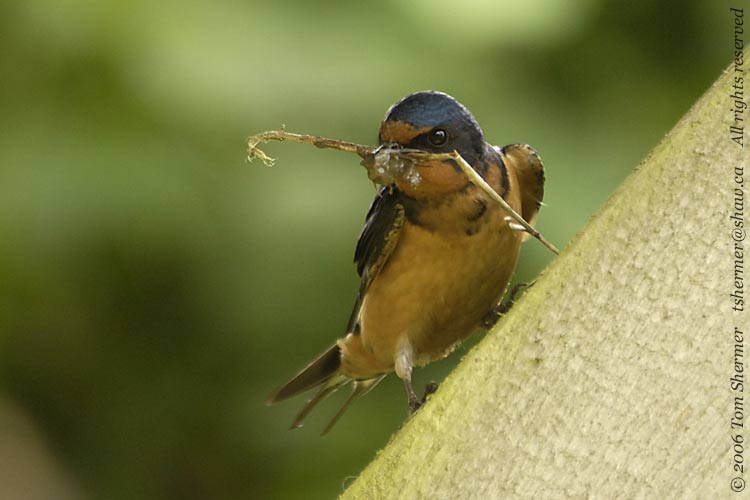 |
|
Now, we humans may
think we're smart, and we invented construction materials like
rebar and reinforced concrete, but swallows were doing that trick
long before we were. Heck, they've been doing it since long before
the day that Rome was built.
(And those Romans would've
called my industrious Barn Swallow a Hirundo rustica.)
After taking a lot
of photos of the swallows, I left them to their nesting and headed
down the line of cottonwoods. A minute or so later, I encountered
a birder who I had chatted with a little when she passed me on
the dyke. And to my surprise, she was walking with someone else,
and the someone else turns out to be my friend Carlo. He must've
been on the dyke ahead of us.
Anyhow, they were headed
back down the dyke to try to find the funny-sounding flycatcher.
I figured that this would be my best chance to find the bird,
and so I abandon my search of the cottonwoods and go back with
them. Besides which, Carlo's always good company.
Well, Carlo's got good
ears, and he found the bird fairly quickly. As the three of us
listened to the bird, I came to realize that I wasn't actually
hearing anything, myself. I could pretend to listen, but that
bird's call was just completely out of the range of my hearing.
Anyhow, the bird did
show himself, so I did get a few photos of him.
|
|
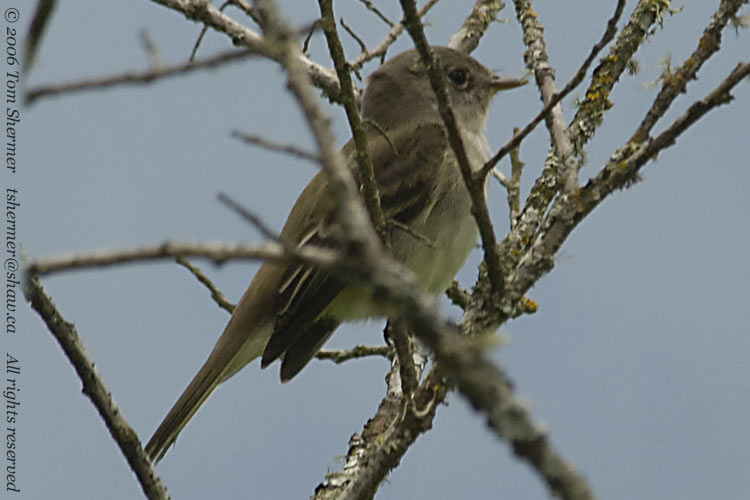 |
|
The strange song of
this bird is important, because there are two species of flycatcher
(the Willow Flycatcher and the Alder Flycatcher) that look almost
(if not exactly) the same, and the only reliable way to tell them
apart in the field is by their song. In these parts, we get a
lot of Willow Flycatchers, and reports of Alder Flycatchers cause
birders to get up off their couches and take notice. This bird
was giving a song that wasn't quite Willow, and wasn't quite Alder.
Carlo was really hoping to turn it into an Alder, but I think
the final verdict on the bird was "strange Willow".
Here's one more look at him.
|
|
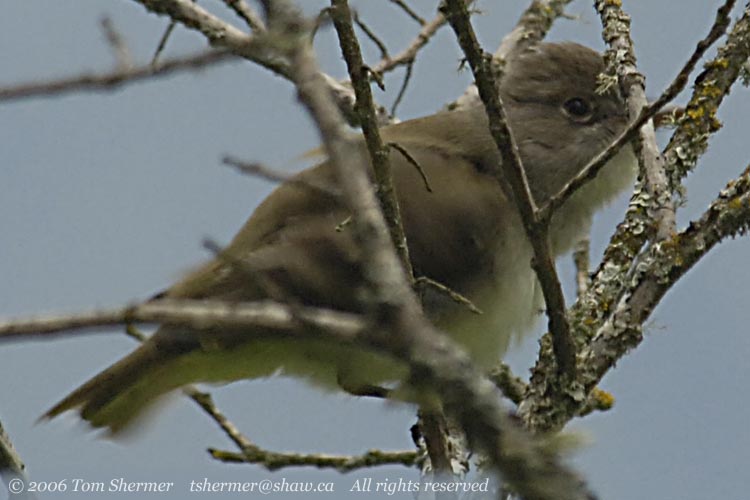 |
| After the
others tired of listening to the flycatcher, we headed on down the
dyke to the location where the American Redstart had been spotted.
Soon enough, Carlo spotted the bird, and I got a few photos of him
when he came in close to us. |
|
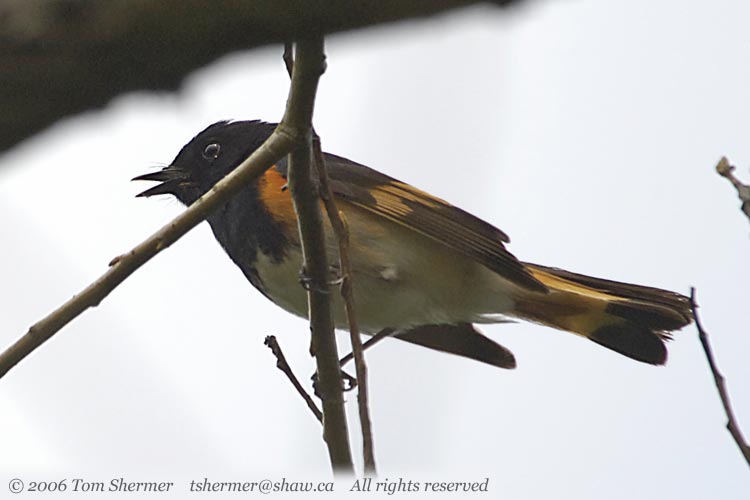 |
|
That was very cool...coming
back with Carlo had certainly paid off.
The others headed on
as I waited in hopes that the redstart would come back and give
me unobstructed camera angles, but soon I hear some (human) calling,
and I head down the trail to find Carlo looking at an Eastern
Kingbird across the slough to the south.
Eastern Kingbirds are
large flycatchers with a black-and-white color scheme.
|
|
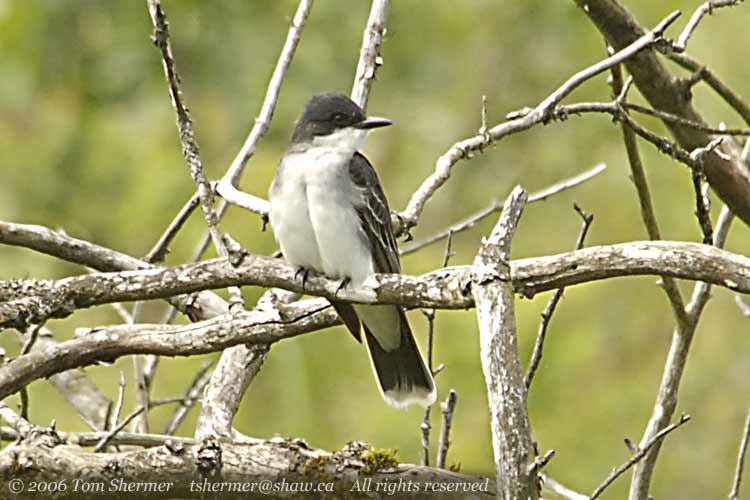 |
|
Carlo facetiously suggested
that with my camera I should get good photos that show the red
stripe on the back of the kingbird's head. Now, I'd never seen
a red stripe on a kingbird's head, but Carlo went on to explain
(with some lament) that he had a guide book that showed a red
stripe there, and that he'd spent years looking at kingbirds specifically
for the red stripe and never seen it.
Carlo and the other
birder went on, and I stayed behind shooting the kingbird. I even
got a few shots of him when he turned his head. It was only after
I got home that I saw that these shots actually show a stripe
right down the middle of the head, and that the stripe is vaguely
red.
|
|
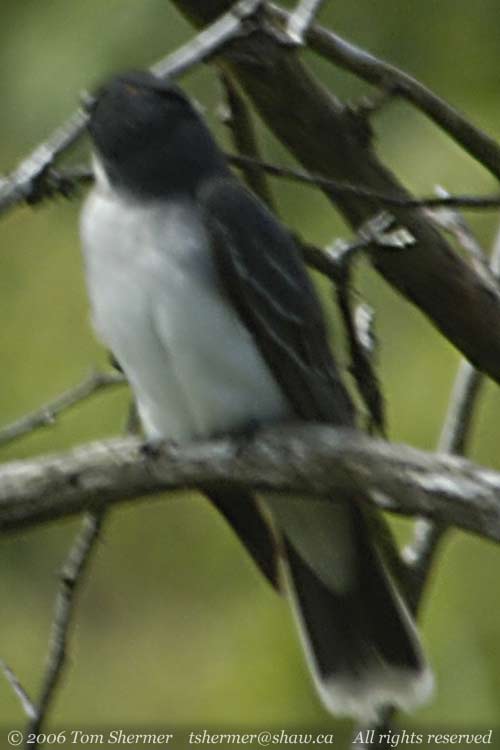 |
|
I have another, more
blurry photo where the color is more obviously red, but if you're
sensitive to color you should be able to tell even from this photo.
I soon was on my way,
and made it back to the end of the dyke without finding any further
subjects. I decided that I'd ditch my tripod and walk north to
the near observation tower. As I started towards my car, though,
I got distracted by Sally here, who was meandering across the
road in front of the snack bar.
|
|
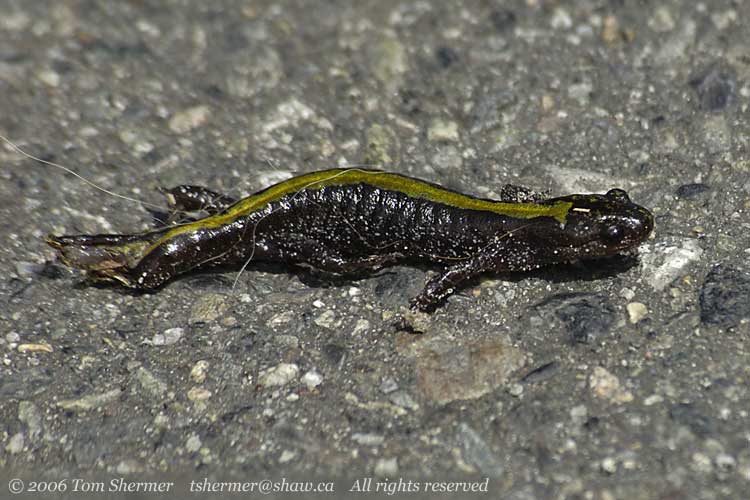 |
|
Sally, naturally, is
a salamander. A Western Long-toed Salamander, to be precise (or,
as my pal Nero would say, Ambystoma macrodactylum). It
looked as if she had some damage to her tail and was growing a
new one.
As she moved on, I
dropped my tripod in my car trunk and headed out to the near tower.
Most of the time when
I go out to an observation tower, the convention has been that
the people are on the tower, and they look at the birds. Today
it just seemed that that convention had been turned around, and
the rule was that the birds were on the tower, looking at the
people.
|
|
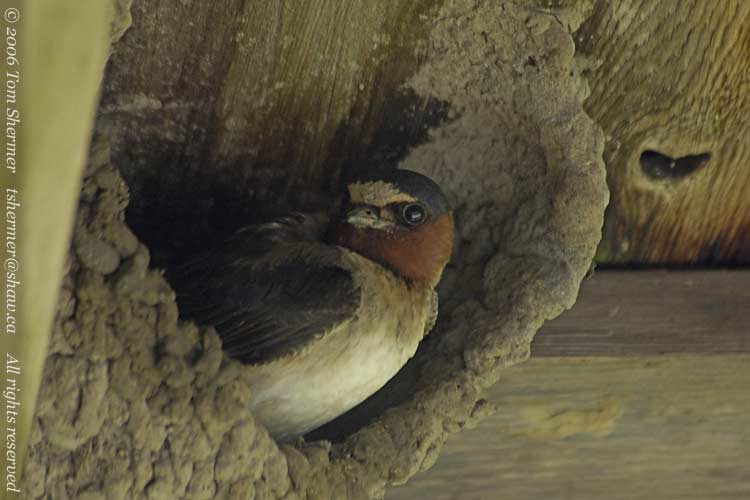 |
|
This was another swallow,
only this was a Cliff Swallow, and he (and several friends) were
nesting under the roof of the structure (as opposed to the Barn
Swallows, who were nesting under the stairs of the other one).
Like Barns, Cliffs build their homes mainly out of mud.
And every good home
starts with a good foundation. Here I caught a Cliff applying
mud to the wood to form the foundation that will support his nest.
|
|
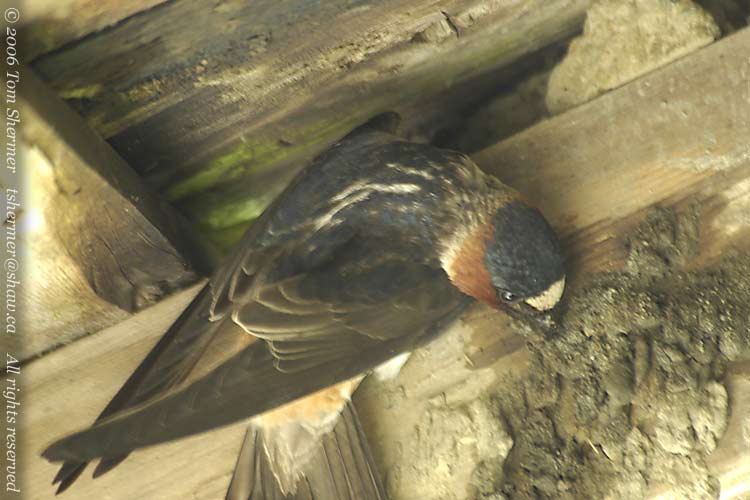 |
| This next
swallow has her nest either all done or nearly so. Cliffs' nests
are gourd-shaped with a side opening, whereas Barns build cup-shaped
nests with a top opening. Cliffs nest communally, with many nests
in close proximity, and Barns nest individually. |
|
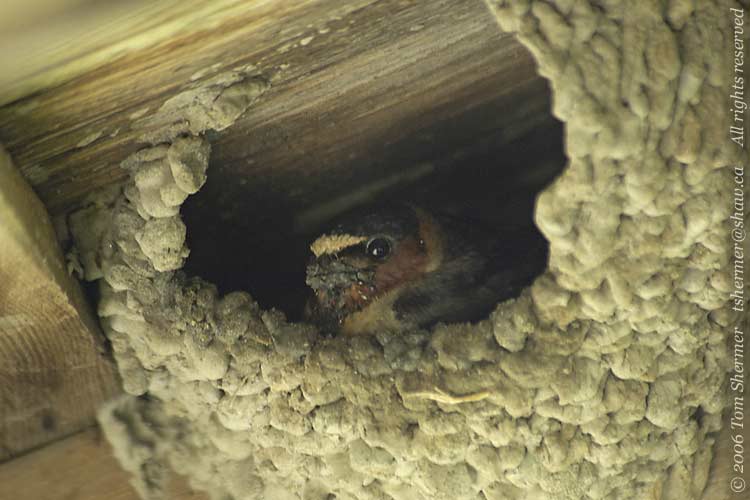 |
|
Now, that girl may
be appealing to another Cliff Swallow, but I personally wish that
she'd go wash the mud off her face.
Oh well, maybe it's
some new beauty treatment...
I'll show you one more
photo of the Cliffs, this one showing two sitting in a half-built
nests. They're quite distinctive birds, with red and the blue
and the big white patch on their forehead.
|
|
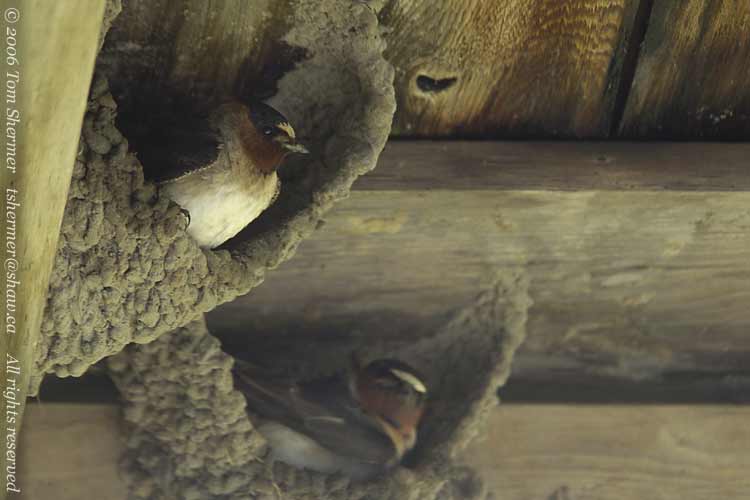 |
|
I had been expecting
the Cliff Swallow nests, because as I walked towards the tower,
I saw a lot of Cliffs flying back and forth from the marsh to
the tower. They were collecting mud from the marsh to build their
nests.
It was about 1:30 and
I was getting tired and hungry, so I made the short walk back
to the parking lot. There were a few Barn Swallows hanging around
the snack bar and caretaker house, and I got some shots of one
on the roof of the house.
|
|
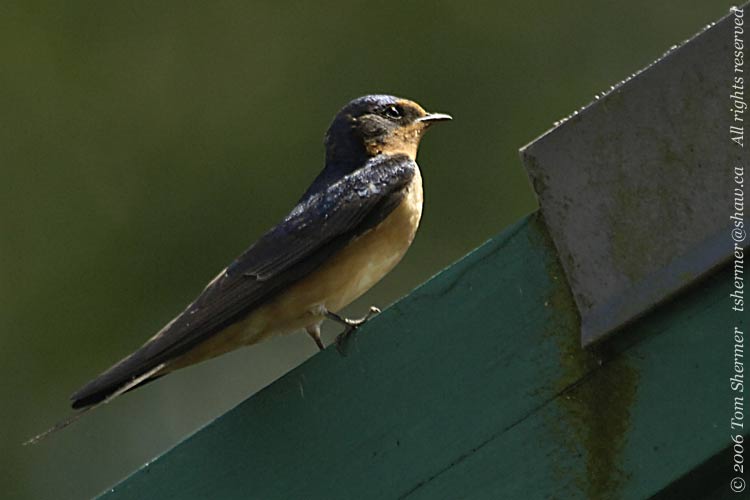 |
|
I sat and rested a
few minutes before driving on. On the way back, at a place where
Rennie Road crosses a river, I pulled over when I saw some medium-sized
birds in the bushes. A quick glance through my Roman binoculars
told me they were Columba fasciata, and so I got out and
got more identifiable pigeon
photos than I had gotten in the morning.
|
|
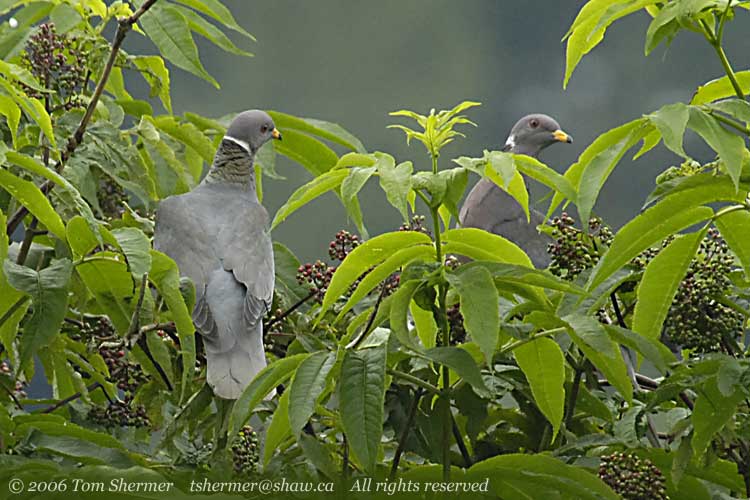 |
|
They were quite wary,
though, and I wasn't able to close the gap any further to get
better photos..
Veni, vidi, luxigraphi,
Tom
|
|
|